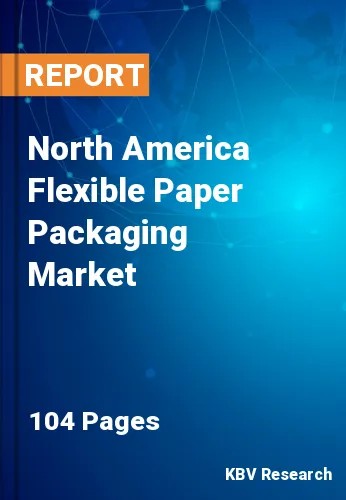The North America Flexible Paper Packaging Market would witness market growth of 3.6% CAGR during the forecast period (2021-2027).
Flexible packaging uses less water and energy to create and transport, and emits less greenhouse gases as it travels to market. Flexible packaging eventually leads in less consumer trash being delivered to landfills due to its efficiency in product to package ratios. Flexible packaging allows consumers to see what's inside, increasing shelf attractiveness and boosting customer trust at the point of purchase. It may also be used to a wide range of product categories, giving it shelf appeal in a variety of retail settings.
Flexible packaging paper is becoming more widely utilized for packaging in a variety of sectors. Flexible and lightweight packaging paper is being more widely used in food, medicines, agriculture, cosmetics, personal care, and consumer products, generating value-added possibilities for market players. The food sector is the most profitable market for flexible packaging paper alternatives among these. Consumption of ready-to-eat and frozen foods is increasing across the world, offering lucrative prospects for flexible packaging paper makers.
The growing need for lighter packaging from sectors including pharmaceuticals, food, and other end-users is propelling the flexible packaging market in North America forward. The market is also projected to be driven by the deployment of improved packaging, which eliminates dispensing mistakes. The use of barcodes for anti-counterfeiting is a major element promoting the usage of blister packs in the North American flexible packaging market. The pressure on food and beverage, consumer goods, and pharmaceutical firms to lessen their reliance on plastic is growing all the time, and it has been passed on to packaging providers. Sustainability encompasses not just the product's material, but also the manufacturing process, logistics, functioning, and end-user.
At the moment, sustainable flexible packaging is more reliant on recovering and reusing plastic items. Bags, films, and pouches, are the most popular goods in North America, with PE, paper, PET, Tyvek, and PA being the most popular materials for healthcare packaging. The growing use of lidding films has stemmed from the widespread adoption of blister packaging, which has replaced glass and rigid plastics.
The US market dominated the North America Flexible Paper Packaging Market by Country 2020, and would continue to be a dominant market till 2027; thereby, achieving a market value of $17,560.9 million by 2027. The Canada market is estimated to witness a CAGR of 6% during (2021 - 2027). Additionally, The Mexico market would display a CAGR of 5% during (2021 - 2027).
Based on Embellishing Type, the market is segmented into Hot Foil, Cold Foil, and Others. Based on Printing Technology, the market is segmented into Flexography, Digital Printing, Rotogravure, and Others. Based on Packaging Type, the market is segmented into Pouches, Rollstock, Shrink Sleeves, Wraps and Others. Based on Application, the market is segmented into Food & Beverages, Healthcare, Beauty & Personal Care and Others. Based on countries, the market is segmented into U.S., Mexico, Canada, and Rest of North America.
Free Valuable Insights: The Global Flexible Paper Packaging Market is Estimated to reach $81 Billion by 2027, at a CAGR of 4.1%
The market research report covers the analysis of key stake holders of the market. Key companies profiled in the report include Sealed Air Corporation, Amcor Plc, Mondi Plc, Sappi Limited, DS Smith Plc, Coveris Management GmbH (Sun Capital Partners, Inc.), Sabert Corporation, Wihuri International Oy, Sonoco Products Company, and Huhtamaki Oyj.
By Embellishing Type
By Printing Technology
By Packaging Type
By Application
By Country
Our team of dedicated experts can provide you with attractive expansion opportunities for your business.

